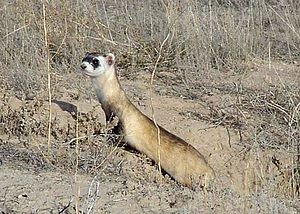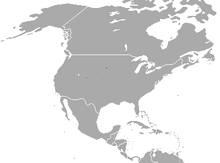Black-footed polecat
| Black-footed polecat | ||||||||||||
|---|---|---|---|---|---|---|---|---|---|---|---|---|

Black-footed piltis ( Mustela nigripes ) |
||||||||||||
| Systematics | ||||||||||||
|
||||||||||||
| Scientific name | ||||||||||||
| Mustela nigripes | ||||||||||||
| ( Audubon & Bachman , 1851) |
The black-footed polecat ( Mustela nigripes ) is a species of predator that is common in North America and belongs to the polecat subgenus within the marten family (Mustelidae). Black-footed pelvises mainly use prairie dogs as prey . The extermination of the prairie dogs classified as agricultural pests in many areas of North America led to a collapse of the black-footed elk population. In 1987 the black-footed elk was considered extinct in the wild. Thanks to breeding programs , the survival of this species could be ensured. The population living in the wild today goes back to captive-bred individuals.
description
Black footed, like all polecats, have an elongated, slender body with short limbs and a relatively short tail. Their fur is predominantly yellow-brown in color, the head is white and has dark, mask-like facial markings around the eyes. The legs and the rearmost part of the tail are also black. These animals reach a head body length of 38 to 50 centimeters, the tail is around 11 to 15 centimeters long and their weight is 0.7 to 1.1 kilograms. Males become around 10% heavier than females.
distribution and habitat
Black-footed pelvises were originally native to the prairie region of central North America. Their distribution area stretched from Alberta and Saskatchewan to Arizona and Texas . Today there are several small populations in Montana , South Dakota , Wyoming, and Arizona, all of which are due to resettlement programs. Their habitat are grasslands.
Lifestyle and diet
The way of life of the Schwarzfußiltisse is closely linked to prairie dogs . They use their burrows as resting places and hunting grounds. They go hunting at dusk or at night and during the day they retreat to their burrows, which are mostly converted prairie dog houses. They live solitary and defend their territory vehemently against conspecifics.
Accordingly, prairie dogs make up 90% of their food, and to a lesser extent they also consume other small mammals such as other ground squirrels and mice .
Reproduction
The mating season is in March and April, after around 42 to 45 days of gestation, the female gives birth to one to six (on average three) young in May or June. In autumn they separate from their mother and they reach sexual maturity at around one year. The life expectancy of animals in human care was up to twelve years.
Threat and protection
Black-footed turtles were widespread until the beginning of the 20th century. Their number is estimated at five to six million at the beginning of the 20th century. At that time, prairie dogs, their main source of food, were still widespread and very high in the prairies of North America. With the widespread extermination of the prairie dogs, which were considered to be agricultural pests, a very strong and rapid decline in the population of the black-footed dogs began. In the US state of Oklahoma , black-footed pills were no longer observed in 1932; in Nebraska they were extinct in 1949.
Breeding efforts began as early as the late 1960s. In 1964, in the west of South Dakota situated Mellette County discovered a small population of Schwarzfußiltissen. Six of the animals were caught in 1971 to begin an offspring program. However, these died after unexpected complications from a distemper vaccination . With more catches from this population, however, one tried again to establish a breeding program. The wild population in South Dakota went extinct in 1975, the last individual from the captive part of this population died in 1979. The species was therefore considered extinct.
A chain of coincidences led to the discovery of a hitherto unknown colony of prairie dogs in Wyoming , which also included black-footed turtles. A farm dog had killed a weasel-like animal, the owner of the dog brought the carcass to a taxidermist to have the carcass stuffed. The taxidermist was not aware of the species, which prompted him to call a conservationist. In October of this year, two biologists managed to catch a live black-footed polecat in this region. An intensive search then led to the discovery of a large colony of prairie dogs, in which, according to a census in 1982, no less than 129 black-footed kittis lived. In the spring of 1985, however, the population had fallen to 52 polecats and in autumn, due to the outbreak of a distemper epidemic, only 16 individuals were left. A re-breeding program was decided and the trapping of individuals began during 1985. The current population goes back to 18 individuals that were caught in this colony.
The breeding program was successful, and in 1991 the black-footed kilt was released for the first time. By 2001 there had been releases in the Charles M. Russel National Wildlife Refuge and Bellnap Indian Reservation (both in eastern Montana ), in Badlands National Park and Buffalo Gap National Grasslands (both in western South Dakota), in eastern Wyoming ( Shirley Basin), in the northwest of Arizona (Aubrey Valley) and in the borderlands of Utah and Colorado (Coyoty Basin) as well as in Janus in the north of the Mexican state Chihuahua , where the largest prairie dog colony currently exists. Not all of these resettlements have been successful; In both Wyoming and the Colorado / Utah area, the animals released into the wild all died of disease. The two reintroductions in South Dakota are considered particularly successful, where a total of 225 young animals were born between 1994 and 2001 and the population there is estimated to be 200 individuals. The total population in 2005 was again estimated at 500 specimens.
literature
- Ronald M. Nowak: Walker's Mammals of the World . Johns Hopkins University Press, 1999 ISBN 0-8018-5789-9
- Paul A. Johnsgard: Great Wildlife of the Great Plains . University Press of Kansas, 2003, ISBN 0-7006-1224-6
Web links
- Mustela nigripes in the endangered Red List species the IUCN 2006. Posted by: Mustelid Specialist Group, 1996. Retrieved on 10 May, 2006.
Single receipts
- ^ Paul A. Johnsgard: Great Wildlife of the Great Plains . University Press of Kansas, 2003, ISBN 0-7006-1224-6 , p. 60
- ^ Paul A. Johnsgard: Great Wildlife of the Great Plains . University Press of Kansas, 2003, ISBN 0-7006-1224-6 , p. 60
- ^ Paul A. Johnsgard: Great Wildlife of the Great Plains . University Press of Kansas, 2003, ISBN 0-7006-1224-6 , p. 61
- ^ Paul A. Johnsgard: Great Wildlife of the Great Plains . University Press of Kansas, 2003, ISBN 0-7006-1224-6 , p. 61
- ^ Paul A. Johnsgard: Great Wildlife of the Great Plains . University Press of Kansas, 2003, ISBN 0-7006-1224-6 , p. 62
- ^ Paul A. Johnsgard: Great Wildlife of the Great Plains . University Press of Kansas, 2003, ISBN 0-7006-1224-6 , p. 63



